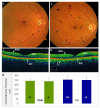Clinical and Molecular-Genetic Insights into the Role of Oxidative Stress in Diabetic Retinopathy: Antioxidant Strategies and Future Avenues
- PMID: 33182408
- PMCID: PMC7697026
- DOI: 10.3390/antiox9111101
Clinical and Molecular-Genetic Insights into the Role of Oxidative Stress in Diabetic Retinopathy: Antioxidant Strategies and Future Avenues
Abstract
Reactive oxygen species (ROS) overproduction and ROS-signaling pathways activation attack the eyes. We evaluated the oxidative stress (OS) and the effects of a daily, core nutritional supplement regimen containing antioxidants and omega 3 fatty acids (A/ω3) in type 2 diabetics (T2DM). A case-control study was carried out in 480 participants [287 T2DM patients with (+)/without (-) diabetic retinopathy (DR) and 193 healthy controls (CG)], randomly assigned to a daily pill of A/ω3. Periodic evaluation through 38 months allowed to outline patient characteristics, DR features, and classic/OS blood parameters. Statistics were performed by the SPSS 24.0 program. Diabetics displayed significantly higher circulating pro-oxidants (p = 0.001) and lower antioxidants (p = 0.0001) than the controls. Significantly higher plasma malondialdehyde/thiobarbituric acid reactive substances (MDA/TBARS; p = 0.006) and lower plasma total antioxidant capacity (TAC; p = 0.042) and vitamin C (0.020) was found in T2DM + DR versus T2DM-DR. The differential expression profile of solute carrier family 23 member 2 (SLC23A2) gene was seen in diabetics versus the CG (p = 0.001), and in T2DM + DR versus T2DM - DR (p < 0.05). The A/ω3 regime significantly reduced the pro-oxidants (p < 0.05) and augmented the antioxidants (p < 0.05). This follow-up study supports that a regular A/ω3 supplementation reduces the oxidative load and may serve as a dietary prophylaxis/adjunctive intervention for patients at risk of diabetic blindness.
Keywords: antioxidants; candidate biomarkers; omega-3 fatty acids; oxidative stress; prevention of blindness; retinopathy; type 2 diabetes mellitus.
Conflict of interest statement
All authors of this work have disclosed that they have no significant financial relationships or financial interests in the commercial companies that are related to this study or paper.
Figures




Similar articles
-
Enhanced Oxidative Stress and Other Potential Biomarkers for Retinopathy in Type 2 Diabetics: Beneficial Effects of the Nutraceutic Supplements.Biomed Res Int. 2015;2015:408180. doi: 10.1155/2015/408180. Epub 2015 Nov 4. Biomed Res Int. 2015. PMID: 26618168 Free PMC article.
-
Retinopathy in non diabetics, diabetic retinopathy and oxidative stress: a new phenotype in Central Africa?Int J Ophthalmol. 2014 Apr 18;7(2):293-301. doi: 10.3980/j.issn.2222-3959.2014.02.18. eCollection 2014. Int J Ophthalmol. 2014. PMID: 24790873 Free PMC article.
-
Oxidative Stress, Inflammatory, Angiogenic, and Apoptotic molecules in Proliferative Diabetic Retinopathy and Diabetic Macular Edema Patients.Int J Mol Sci. 2023 May 4;24(9):8227. doi: 10.3390/ijms24098227. Int J Mol Sci. 2023. PMID: 37175931 Free PMC article.
-
Diabetic retinopathy and the role of Omega-3 PUFAs: A narrative review.Exp Eye Res. 2023 Jun;231:109494. doi: 10.1016/j.exer.2023.109494. Epub 2023 May 5. Exp Eye Res. 2023. PMID: 37149278 Review.
-
Oxidative stress: implications for the development of diabetic retinopathy and antioxidant therapeutic perspectives.Oxid Med Cell Longev. 2014;2014:752387. doi: 10.1155/2014/752387. Epub 2014 Aug 10. Oxid Med Cell Longev. 2014. PMID: 25180070 Free PMC article. Review.
Cited by
-
Searching for the Antioxidant, Anti-Inflammatory, and Neuroprotective Potential of Natural Food and Nutritional Supplements for Ocular Health in the Mediterranean Population.Foods. 2021 May 28;10(6):1231. doi: 10.3390/foods10061231. Foods. 2021. PMID: 34071459 Free PMC article. Review.
-
Mechanism of the antidiabetic action of Nigella sativa and Thymoquinone: a review.Front Nutr. 2023 Sep 25;10:1126272. doi: 10.3389/fnut.2023.1126272. eCollection 2023. Front Nutr. 2023. PMID: 37818339 Free PMC article. Review.
-
Resilience to diabetic retinopathy.Prog Retin Eye Res. 2024 Jul;101:101271. doi: 10.1016/j.preteyeres.2024.101271. Epub 2024 May 11. Prog Retin Eye Res. 2024. PMID: 38740254 Free PMC article. Review.
-
Emerging innovations in ophthalmic drug delivery for diabetic retinopathy: a translational perspective.Drug Deliv Transl Res. 2025 Jul 20. doi: 10.1007/s13346-025-01925-6. Online ahead of print. Drug Deliv Transl Res. 2025. PMID: 40685494
-
Signature of Circulating Biomarkers in Recurrent Non-Infectious Anterior Uveitis. Immunomodulatory Effects of DHA-Triglyceride. A Pilot Study.Diagnostics (Basel). 2021 Apr 19;11(4):724. doi: 10.3390/diagnostics11040724. Diagnostics (Basel). 2021. PMID: 33921773 Free PMC article.
References
-
- Chawla R., Madhu S.V., Makkar B.M., Ghosh S., Saboo B., Kalra S. On behalf of RSSDI-ESI Consensus Group RSSDI-ESI clinical practice recommendations for the management of Type 2 diabetes mellitus 2020. Int. J. Diabetes Dev. Ctries. 2020;40(Suppl. S1–S122):1–122. doi: 10.1007/s13410-020-00819-2. - DOI - PMC - PubMed
-
- Hammes H.P., Welp R., Kempe H.P., Wagner C., Siegel E., Holl R.W. DPV initiative—German BMBF competence network diabetes mellitus. Risk factors for retinopathy and diabetic macular edema in Type 2 diabetes-results from the German/Austrian DPV Database. PLoS ONE. 2015;10:e0132492. doi: 10.1371/journal.pone.0132492. - DOI - PMC - PubMed
Grants and funding
LinkOut - more resources
Full Text Sources

